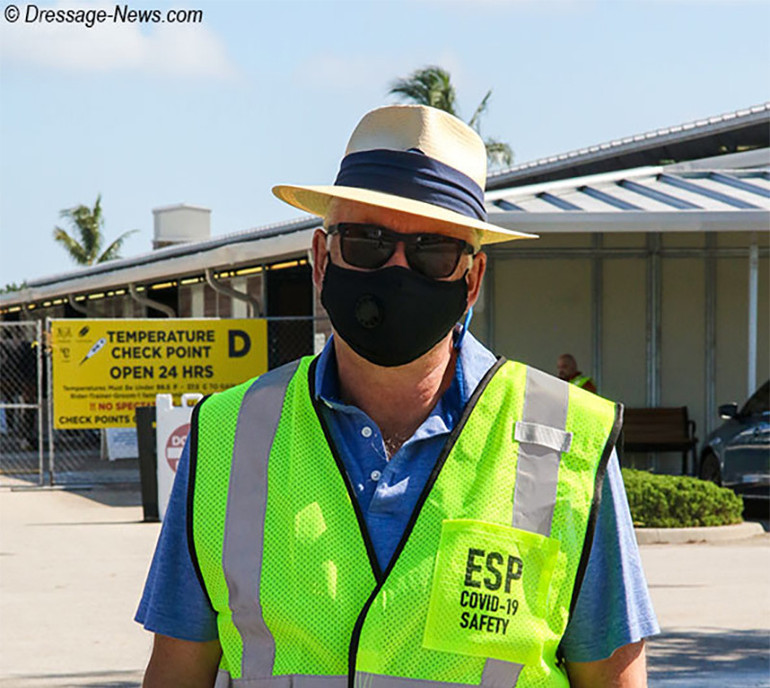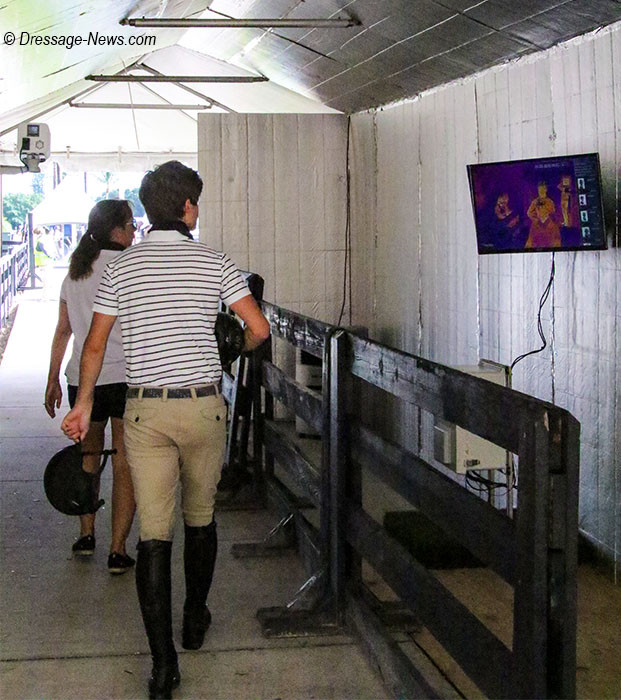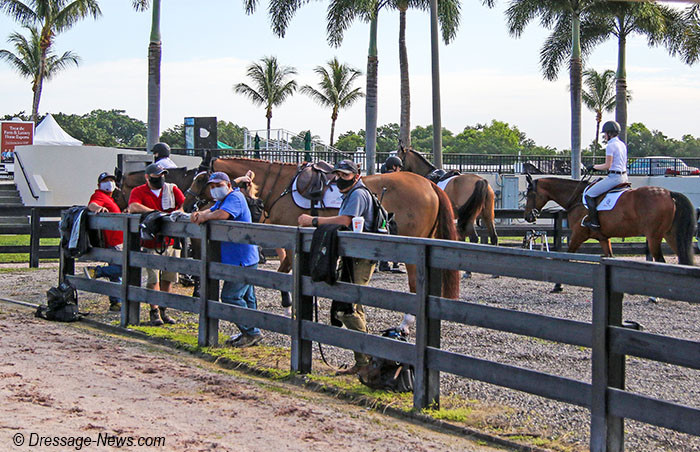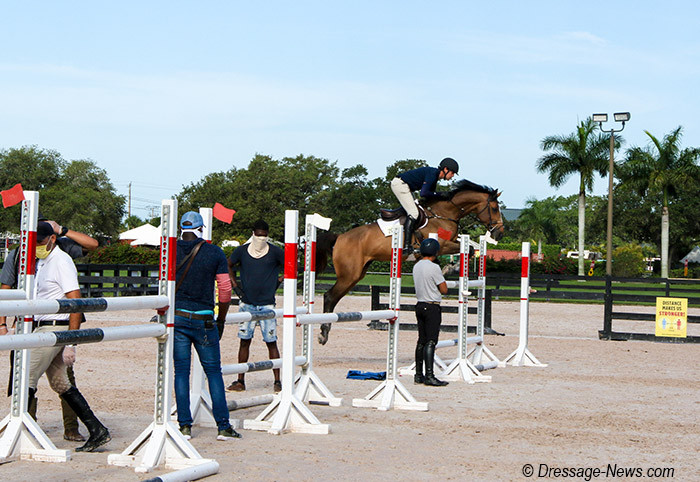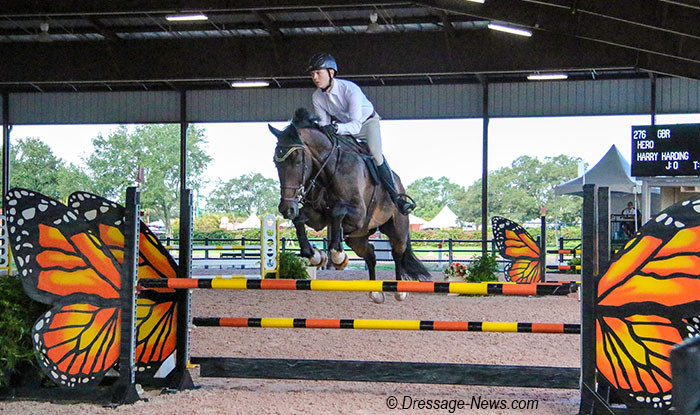Text © World of Showjumping
As equestrian competitions return to Wellington, Florida in the wake of the Covid-19 pandemic, World of Showjumping speaks with Equestrian Sports Production president Michael Stone – who has been influential in establishing what the ‘new normal’ of jumping should look like in the US. Over the last months, Stone has worked closely with USEF, the local government, town and county politicians as well as the health authorities to bring horses and riders back in the ring.
“The most complicated process has been writing out the protocol ‘ESP Covid-19 Competition Action Plan’. However, most of what we suggested was also agreed upon by USEF that have used much of the same content for their mandatory requirements. Now that it’s been done it should be quite easy for other US show organisers to go ahead too,” Stone begins.
“As a show organiser the first step to be able to resume to competition is to complete the WHO Mass Gathering for Sports Risk Assessment Tool. We were considered low risk with a mitigation score of 86%,” Stone tells about ESP’s start-up process.
A lot of precautions have been taken and are all outlined in detail in the ‘ESP Covid-19 Competition Action Plan’. “The first thing to take care of is obviously the number of people allowed at the show grounds,” Stone tells. “No spectators are allowed here. Next to the riders, only one groom, one trainer and one extra person per horse is permitted to enter. ESP is also asking for everyone’s phone number and email address to use in the case of notification requirements.”
“We have also moved our competition to our dressage facilities, that normally hosts the Global Dressage Festival. It’s a much easier venue to control when it comes to entrance – so everyone feels comfortable and safe,” Stone tells.
“Those entering the show grounds have to walk through a tent with thermal camera scanning systems. Everyone is checked by either the cameras or by security with a touchless thermometer before they are allowed access. Anyone with a temperature below 99.5° F (37.5° C) can enter the facility. If the temperature is higher, a cooling down process is allowed and before we re-check – however, if the temperature does not drop, we will not allow access until the person in question has a negative test. We also ask that everyone check their own temperature at home before coming in to avoid any incident of possible exposure before this mandatory check at the entry gate. The cameras speed the entry process up though, and help people feel safe. It was a big investment, but necessary. So far, people have been very co-operative and there have been no problems,” Stone tells.
“Furthermore, everyone at the show grounds must wear mask with the only exception being when riders are on horse-back,” Stone continues. “There are strict hand sanitizing requirements for everyone. Then we obviously also have very strict social distancing rules, which are enforced by security personnel. As it’s hard to tell who belongs in a family or group and not, we ask everyone to respect the distancing rules once they are out of their cars. We also encourage everyone to come, show and leave – not hang around. It’s not the easiest to apply, but again people have been very co-operative.”
“We have also made adjustments to procedures such as course walk, warm-up and anything that potentially would require a visit to the show office,” Stone tells. “All courses – with distances – are posted on our website. If allowed, course walks are to be extremely brief with social distancing protocols strictly enforced. In the warm-up, a maximum of two people will be allowed per schooling jump and on opposite sides. Jumps will be spaced at least 10’ apart. Everyone has to use gloves when on the schooling jumps, and these have been treated with a special product that is used in hospitals to coat surfaces that prevent areas for viruses to attach to.”
“We’ve been very clear to everyone that if one person messes up, it will have huge consequences as we risk everything being shut down,” Stone says. “Hence, we stress again and again that everyone needs to co-operate and respect the rules. Generally, I would say it’s been going smooth. People realise we are privileged to be back up and running – everyone is willing to do their best and make the most out of the chance we have been given.”
Transitioning from national to international competitions will be the next challenge for Stone and his team. “Obviously, as international competition returns – also to Tryon and Traverse City – the numbers of horses will go up and so will the amount of people. This will probably create a more challenging scenario than the current one,” Stone says. “Right now, we are planning for FEI competitions to return in June and July in Tryon as well as hosting a five-star show also in Tryon in the fall.”
“We all know we are sailing into the unknown here,” Stone continues. “None of us know if there will be a second wave, or if the worst is past us, so there is a lot of uncertainty. In the US, we at least have the advantage that we can travel internally without restrictions. In Europe, the situation is more complex seeing that there are different restrictions and rules in different countries. It’s not without complication to travel from one country to another to compete when some governments lift the quarantine rules and some don’t, or some allow their citizens to travel abroad while some advice not to.”
Stone is not too optimistic about international jumping returning to its former self in post-pandemic times. “I think one consequence of this crisis is that our sport will be less global than we knew it, at least until there is a cure or a vaccine available,” Stone says. “We also have to take into consideration that the athletes and their owners need to feel safe to travel, and I think many don’t at this stage. I don’t imagine much of a big winter season in 2020, but I can vision it slowly returning early spring next year. But you never know, perhaps everything will be fine again in a few months.”
“In my opinion the Global Champions Tour was clever to abandon this season, because the way I see it hosting build-up events of this size anywhere in the world will be difficult,” Stone says. “The biggest problem at the moment is all the uncertainty, and that we just don’t know what will happen next. Furthermore, horses need to jump themselves back to that level when the time comes. For example, it’s just not to go to the Nations Cup Final in Barcelona and jump straight at championship level; the horses need to be ready for that.”
When it comes to financial aspects, Stone believes that there are tough times ahead. “I think the biggest sponsors will still be there when the sport resumes, but for the smaller ones it will perhaps be a challenge,” Stone says when asked about the prospect of continued economic backing for the sport. “We have to be creative and add value to their sponsorships. At ESP, we have been looking at using social media more than before and create extensive virtual visibility for our sponsors, partners and vendors. Perhaps the FEI should also look at relaxing the sponsorship branding for the riders, so that they can promote their sponsors even more than now. We are all in this together and we are all suffering economically.”
“For many organisers, the biggest loss comes from not being able to have hospitality areas or spectators. It is by far the biggest challenge,” Stone says about the financial aspects. “And it’s no way that this can happen with the current social distancing rules. Without hospitality and spectators as well as less sponsorship opportunities we must expect a drop in the prize money. Hopefully, riders will be understanding. Together, we all have to sacrifice something to get the sport going again.”
On a positive note, Stone has witnessed good things coming out of the corona-crisis too. “The good news is that the horses had a proper break and for them the benefit will be huge. I also think it’s healthy for the riders to stay at home, instead of doing this kind of non-stop travelling we have seen over the last years. Furthermore, the co-operation between the show organisers has been encouraging. All of us want to come back at it, so we have all exchanged ideas and it has been amazing to experience everyone coming together to help each other.”
No reproduction without written permission, copyright text © World of Showjumping – copyright photos © Ken Braddick/dressage-news.com



